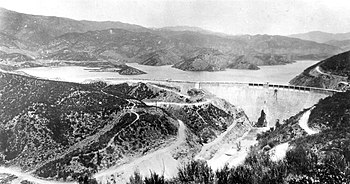
Back سد سانت فرانسيس ARZ St.-Francis-Talsperre German Barrage de St. Francis French Diga St. Francis Italian सेंट फ्रांसिस धरण Marathi
| St. Francis Dam | |
|---|---|
 View of the dam looking north, with water in its reservoir, in February 1927 | |
| Location | Los Angeles County, California, U.S. |
| Coordinates | 34°32′49″N 118°30′45″W / 34.54694°N 118.51250°W |
| Construction began | 1924 |
| Opening date | 1926 |
| Demolition date | 1929 |
| Dam and spillways | |
| Impounds | Los Angeles Aqueduct San Francisquito Creek |
| Height | 185 ft (56 m) |
| Height (foundation) | 205 ft (62 m) |
| Length | main dam 700 ft (210 m) wing dike 588 ft (179 m) |
| Elevation at crest | parapet 1,838 ft (560 m) spillway 1,835 ft (559 m) |
| Width (crest) | 16 ft (4.9 m) |
| Width (base) | 170 ft (52 m) |
| Parapet width | 16 ft (4.9 m) |
| Hydraulic head | 182 ft (55 m) |
| Dam volume | main dam 130,446 cu yd (99,733 m3) wing dike 3,826 cu yd (2,925 m3) |
| Spillway type | uncontrolled overflow |
| Reservoir | |
| Total capacity | 38,168 acre⋅ft (47.080×106 m3) |
| Catchment area | 37.5 sq mi (97 km2) |
| Maximum length | 3 mi (4.8 km) |
| Maximum water depth | 182 ft (55 m) |
| Official name | St. Francis Dam Disaster Site[1] |
| Designated | April 26, 1978 |
| Reference no. | 919 |
| Official name | Saint Francis Dam Disaster |
| Designated | March 12, 2019 |
| Official name | Saint Francis Dam Disaster |
| Designated | March 12, 2019 |
The St. Francis Dam, or the San Francisquito Dam, was a concrete gravity dam located in San Francisquito Canyon in northern Los Angeles County, California, United States, that was built between 1924 and 1926. The dam failed catastrophically in 1928, killing at least 431 people in the subsequent flood,[2][3] in what is considered to have been one of the worst American civil engineering disasters of the 20th century and the third-greatest loss of life in California history.[4][5][6]
The dam was built to serve the growing water needs of the city of Los Angeles, creating a large regulating and storage reservoir that was an integral part of the Los Angeles Aqueduct. It was located in San Francisquito Canyon of the Sierra Pelona Mountains, about 40 miles (64 km) northwest of downtown Los Angeles, and approximately 10 miles (16 km) north of the present day city of Santa Clarita.
However, a defective soil foundation and design flaws led to the dam's collapse just two years after its completion. Its failure ended the career of William Mulholland, the general manager and chief engineer of the Bureau of Water Works and Supply (now the Los Angeles Department of Water and Power).[7]
- ^ Cite error: The named reference
CHLwas invoked but never defined (see the help page). - ^ Stansell, Ann (August 2014). Memorialization and Memory of Southern California's St. Francis Dam Disaster of 1928. California State University, Northridge (Thesis).
- ^ Stansell, Ann C. (February 2014). "Roster of St. Francis Dam Disaster Victims". Santa Clarita Valley History In Pictures.
- ^ Peter Hartlaub (January 11, 2023). "How bad was California's 'Great Flood' of 1862? It was a torrent of horrors". San Francisco Tribune. Archived from the original on January 20, 2023. Retrieved July 3, 2023.
- ^ Jon Schlosberg (December 7, 2020). "California's 'trillion dollar' mega disaster no one is talking about". ABC 7 Chicago. Archived from the original on December 7, 2020. Retrieved September 20, 2021.
- ^ "California's Worst Disasters Remembered" seecalifornia.com. Quote: "600 people in 1928 died in the St. Francis Dam flood in Santa Clarita. It was around midnight that Southern California suffered one of the worst disasters in the state's history, second only to the earthquake and fire that devastated San Francisco in 1906."
- ^ Cite error: The named reference
William Mulhollandwas invoked but never defined (see the help page).